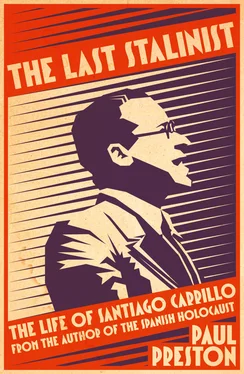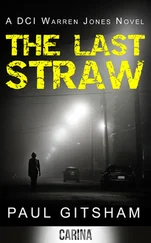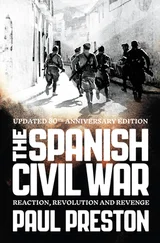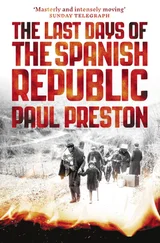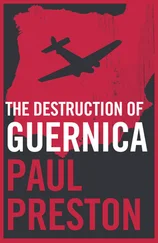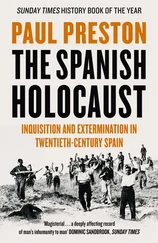All these sacas were initiated with documentation on Dirección General de Seguridad notepaper indicating that the prisoners were either to be released or taken to Chinchilla or Alcalá de Henares. When the order was for them to go to Alcalá de Henares, they usually arrived safely. This suggests that ‘to be released’ ( libertad ) and ‘Chinchilla’ were codewords for elimination. 99The specific orders for the evacuations of prisoners were not signed by Carrillo, nor by any member of the Junta de Defensa. Until 22 November, such orders were signed by Manuel Muñoz’s second-in-command in the Dirección General de Seguridad, the head of the police Vicente Girauta Linares. Girauta was under the orders of Serrano Poncela, Muñoz’s successor for Madrid. On 22 November, he followed Muñoz to Valencia. Thereafter, the orders were signed either by Serrano Poncela himself or by Girauta’s successor as head of the Madrid police, Bruno Carreras Villanueva. 100In the Causa General, there are several documents signed by Serrano Poncela. The anthology of this colossal archive, published in 1945, reproduces two. The one dated 26 November 1936 read, ‘I request that you release the individuals listed on the back of this page,’ and carried twenty-six names. The document dated 27 November read, ‘Please release the prisoners mentioned on the two attached sheets,’ which listed 106 names. All those on these two lists were assassinated. 101Explicit orders for the execution, as opposed to the ‘liberation’ or ‘transfer’ of prisoners, have not been found.
While the sacas were taking place, Carrillo had started to issue a series of decrees that would ensure Communist control of the security forces within the capital and put an end to the myriad parallel police forces that had sprung up in the first weeks of the war. On 9 November, he issued two decrees that constituted a significant step towards the centralized control of the police and security forces. The first required the surrender of all arms not in authorized hands. The second stated that the internal security of the capital would be the exclusive responsibility of forces organized by the Council for Public Order. This signified the dissolution, on paper at least, of all checas . 102Under the conditions of the siege, Carrillo was thus able to impose, by emergency decree, measures that had been beyond the government. Nevertheless, there was a considerable delay between the announcement of the decree and its successful implementation. The anarchists resisted as long as they could and the Communists never relinquished some of their own checas . Nevertheless, by his decree of 9 November, Carrillo returned the services of security and investigation to the now reformed police and suppressed all those groups run by political parties or trade unions, although many of their militants were given positions in Serrano Poncela’s Public Order Delegation. 103
Explicitly included within these reformed services was ‘everything relative to the administration of the arrest and release of prisoners, as well as the movement, transfer etc of those under arrest’. They were under the control of the Public Order Delegation. 104All functions of the Dirección General de Seguridad were controlled by Serrano Poncela. However, he followed the instructions of Carrillo or his deputy José Cazorla. Carrillo’s measures constituted the institutionalization of the repression under the Public Order Delegation in the Dirección General de Seguridad. 105
Within Serrano Poncela’s Delegation, there were three sub-sections. The first dealt with investigation, interrogations and petitions for release. This was headed by Manuel Rascón Ramírez of the CNT. After interrogations had been carried out, this section made recommendations to the Delegation and final decisions were taken by Carrillo. This function was entirely compatible with the decisions taken at the meeting between JSU and CNT members on the evening of 7 November. The second sub-section, headed by Serrano Poncela himself, dealt with prisons, prisoners and prison transfers. It used small tribunals of militiamen set up in each prison to go through the file-cards of the prisoners. The third sub-section dealt with the personnel of the police and other more or less official armed groups in the rearguard. 106
The procedures that would be applied to prisoners between 18 November and 6 December were established on 10 November at a meeting of the Public Order Delegation. Serrano Poncela laid down three categories: army officers with the rank of captain and above; Falangists; other rightists. This was roughly similar to what had been agreed at the meeting on 7 November between members of the CNT–FAI and representatives of the JSU, one of whom had almost certainly been Serrano Poncela himself. When lists of prisoners were compiled, they were passed to Serrano Poncela. He then signed orders for their ‘release’, which meant their execution. It seems that those expeditions of prisoners that arrived safely at their destination consisted of men not listed for execution by the prison tribunals. Serrano Poncela had to report every day to Carrillo in his office in the Junta de Defensa (in the Palace of Juan March in Calle Núñez de Balboa in the Barrio de Salamanca). Carrillo also often visited the office of Serrano Poncela at Number 37 in nearby Calle Serrano. 107
The procedure was that agents would arrive at each prison late at night with a general order signed by Serrano Poncela for the ‘liberation’ of the prisoners whose names were listed on the back or on separate sheets. The director of the prison would hand them over and they would then be taken to wherever Serrano Poncela had indicated orally to the agents. The subsequent phase of the process, the transportation and execution of the prisoners in the early hours of the following morning, was carried out each day by different groups of militiamen, sometimes anarchists, sometimes Communists and sometimes from the Fifth Regiment. The prisoners were obliged to leave all their belongings, and were then tied together in pairs and loaded on to buses. 108
That Carrillo was fully aware of this is demonstrated by the minutes of the meeting of the Junta de Defensa on the night of 11 November 1936. One of the anarchist consejeros asked if the Cárcel Modelo had been evacuated. Carrillo responded by saying that the necessary measures had been taken to organize the evacuations of prisoners but that the operation had had to be suspended. At this, the Communist Isidoro Diéguez Dueñas, second-in-command to Antonio Mije at the War Council, declared that the evacuations had to continue, given the seriousness of the problem of the prisoners. Carrillo responded that the suspension had been necessary because of protests emanating from the diplomatic corps, presumably a reference to his meeting with Schlayer. Although the minutes are extremely brief, they make it indisputably clear that Carrillo knew what was happening to the prisoners if only as a result of the complaints by Schlayer. 109
In fact, after the mass executions of 7–8 November, there were no more sacas until 18 November, after which they continued on a lesser scale until 6 December. The sacas and the executions have come to be known collectively as ‘Paracuellos’, the name of the village where a high proportion of the executions took place. Those executions constituted the greatest single atrocity perpetrated in Republican territory during the war. Its scale is explained but not justified as a response to the fear that rebel forces were about to take Madrid. Whereas previous sacas had been triggered by spontaneous mass outrage provoked by bombing raids or by news brought by refugees of rebel atrocities, the extra-judicial murders carried out at Paracuellos were the result of political-military decisions. The evacuations and subsequent executions were organized by the Council for Public Order but could not have been implemented without help from other, largely anarchist elements in the rearguard militias.
Читать дальше
